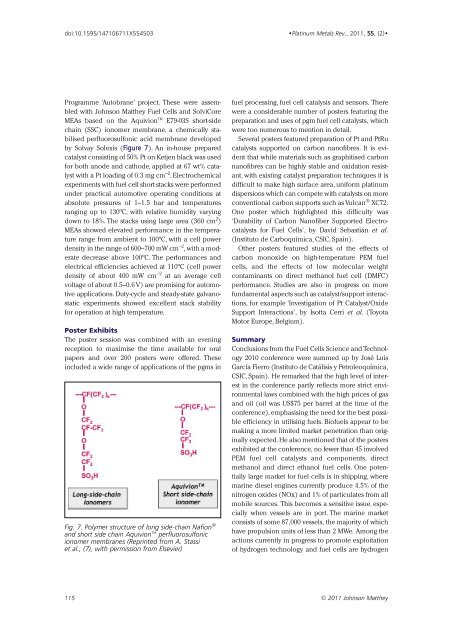Download - Platinum Metals Review
Download - Platinum Metals Review
Download - Platinum Metals Review
Create successful ePaper yourself
Turn your PDF publications into a flip-book with our unique Google optimized e-Paper software.
doi:10.1595/147106711X554503<br />
•<strong>Platinum</strong> <strong>Metals</strong> Rev., 2011, 55, (2)•<br />
Programme ‘Autobrane’ project. These were assembled<br />
with Johnson Matthey Fuel Cells and SolviCore<br />
MEAs based on the Aquivion TM E79-03S short-side<br />
chain (SSC) ionomer membrane, a chemically stabilised<br />
perfluorosulfonic acid membrane developed<br />
by Solvay Solexis (Figure 7). An in-house prepared<br />
catalyst consisting of 50% Pt on Ketjen black was used<br />
for both anode and cathode, applied at 67 wt% catalyst<br />
with a Pt loading of 0.3 mg cm –2 . Electrochemical<br />
experiments with fuel cell short stacks were performed<br />
under practical automotive operating conditions at<br />
absolute pressures of 1–1.5 bar and temperatures<br />
ranging up to 130ºC, with relative humidity varying<br />
down to 18%. The stacks using large area (360 cm 2 )<br />
MEAs showed elevated performance in the temperature<br />
range from ambient to 100ºC, with a cell power<br />
density in the range of 600–700 mW cm −2 , with a moderate<br />
decrease above 100ºC. The performances and<br />
electrical efficiencies achieved at 110ºC (cell power<br />
density of about 400 mW cm −2 at an average cell<br />
voltage of about 0.5–0.6 V) are promising for automotive<br />
applications. Duty-cycle and steady-state galvanostatic<br />
experiments showed excellent stack stability<br />
for operation at high temperature.<br />
Poster Exhibits<br />
The poster session was combined with an evening<br />
reception to maximise the time available for oral<br />
papers and over 200 posters were offered. These<br />
included a wide range of applications of the pgms in<br />
Fig. 7. Polymer structure of long side-chain Nafion ®<br />
and short side chain Aquivion TM perfluorosulfonic<br />
ionomer membranes (Reprinted from A. Stassi<br />
et al., (7), with permission from Elsevier)<br />
fuel processing, fuel cell catalysis and sensors. There<br />
were a considerable number of posters featuring the<br />
preparation and uses of pgm fuel cell catalysts, which<br />
were too numerous to mention in detail.<br />
Several posters featured preparation of Pt and PtRu<br />
catalysts supported on carbon nanofibres. It is evident<br />
that while materials such as graphitised carbon<br />
nanofibres can be highly stable and oxidation resistant,<br />
with existing catalyst preparation techniques it is<br />
difficult to make high surface area, uniform platinum<br />
dispersions which can compete with catalysts on more<br />
conventional carbon supports such as Vulcan ® XC72.<br />
One poster which highlighted this difficulty was<br />
‘Durability of Carbon Nanofiber Supported Electrocatalysts<br />
for Fuel Cells’, by David Sebastián et al.<br />
(Instituto de Carboquímica, CSIC, Spain).<br />
Other posters featured studies of the effects of<br />
carbon monoxide on high-temperature PEM fuel<br />
cells, and the effects of low molecular weight<br />
contaminants on direct methanol fuel cell (DMFC)<br />
performance. Studies are also in progress on more<br />
fundamental aspects such as catalyst/support interactions,<br />
for example ‘Investigation of Pt Catalyst/Oxide<br />
Support Interactions’, by Isotta Cerri et al. (Toyota<br />
Motor Europe, Belgium).<br />
Summary<br />
Conclusions from the Fuel Cells Science and Technology<br />
2010 conference were summed up by José Luis<br />
García Fierro (Instituto de Catálisis y Petroleoquímica,<br />
CSIC, Spain). He remarked that the high level of interest<br />
in the conference partly reflects more strict environmental<br />
laws combined with the high prices of gas<br />
and oil (oil was US$75 per barrel at the time of the<br />
conference), emphasising the need for the best possible<br />
efficiency in utilising fuels. Biofuels appear to be<br />
making a more limited market penetration than originally<br />
expected.He also mentioned that of the posters<br />
exhibited at the conference, no fewer than 45 involved<br />
PEM fuel cell catalysts and components, direct<br />
methanol and direct ethanol fuel cells. One potentially<br />
large market for fuel cells is in shipping, where<br />
marine diesel engines currently produce 4.5% of the<br />
nitrogen oxides (NOx) and 1% of particulates from all<br />
mobile sources. This becomes a sensitive issue, especially<br />
when vessels are in port. The marine market<br />
consists of some 87,000 vessels, the majority of which<br />
have propulsion units of less than 2 MWe. Among the<br />
actions currently in progress to promote exploitation<br />
of hydrogen technology and fuel cells are hydrogen<br />
115 © 2011 Johnson Matthey
















